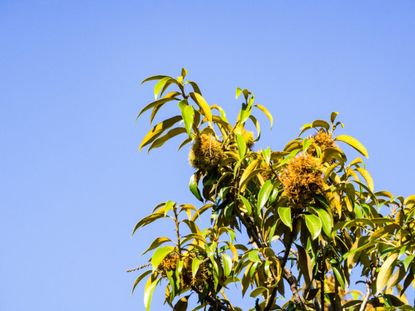Caring For Chinquapins: Tips On Growing Golden Chinquapin


Golden chinquapin (Chrysolepis chrysophylla), also commonly called golden chinkapin or giant chinquapin, is a relative of chestnuts that grows in California and the Pacific Northwest of the United States. The tree is easily identifiable by its long, pointy leaves and spiky, yellow nuts. Keep reading to learn more chinquapin information, such as caring for chinquapins and how to grow golden chinquapin trees.
Golden Chinquapin Information
Golden chinquapin trees have a very broad height range. Some are as small as 10 feet (3 m.) high and are really considered to be shrubs. Others, however, can grow as tall as 150 feet. (46 m.). This huge variance has to do with elevation and exposure, with the shrubbier specimens usually found at high elevations in harsh, windswept conditions. The bark is brown and very deeply furrowed, with ridges that are 1 to 2 inches (2.5-5 cm.) thick. The leaves are long and spear-shaped with distinctive yellow scales on the underside, earning the tree its name. The tops of the leaves are green. The tree produces nuts that are enclosed in bright yellow, spiny clusters. Each cluster contains one to three edible nuts. The trees range natively throughout coastal California and Oregon. In the state of Washington, there are two distinct stands of trees that contain golden chinquapins.
Caring for Chinquapins
Golden chinquapin trees tend to perform best in dry, poor soil. In the wild, they are reported to survive in temperatures ranging from 19 degrees F. (-7 C.) to 98 degrees F. (37 C.). Growing giant chinquapins is a very slow process. A year after planting, seedlings may be only 1.5 to 4 inches (4-10 cm.) tall. After 4 to 12 years, the seedlings usually only reach between 6 and 18 inches (15-46 cm.) in height. The seeds do not need to be stratified and can be planted immediately after harvest. If you are looking to collect golden chinquapin seeds, look into the legality of it first. Your local county extension office should be able to help with that.
Gardening tips, videos, info and more delivered right to your inbox!
Sign up for the Gardening Know How newsletter today and receive a free download of our most popular eBook "How to Grow Delicious Tomatoes."

The only child of a horticulturist and an English teacher, Liz Baessler was destined to become a gardening editor. She has been with Gardening Know how since 2015, and a Senior Editor since 2020. She holds a BA in English from Brandeis University and an MA in English from the University of Geneva, Switzerland. After years of gardening in containers and community garden plots, she finally has a backyard of her own, which she is systematically filling with vegetables and flowers.
-
 Clever Vertical Vegetable Garden Ideas For Small Spaces – 7 Ways To Save Space
Clever Vertical Vegetable Garden Ideas For Small Spaces – 7 Ways To Save SpaceShort on garden space? Learn some vegetable garden ideas for small spaces that are fun and easy.
By Mary Ellen Ellis
-
 26 Different Types Of Orchids – With Pictures & Information
26 Different Types Of Orchids – With Pictures & InformationDiscover stunning orchid types to grow in your home and garden – from easy beginner varieties to rare and exotic species that are the preserve of experts.
By Melanie Griffiths